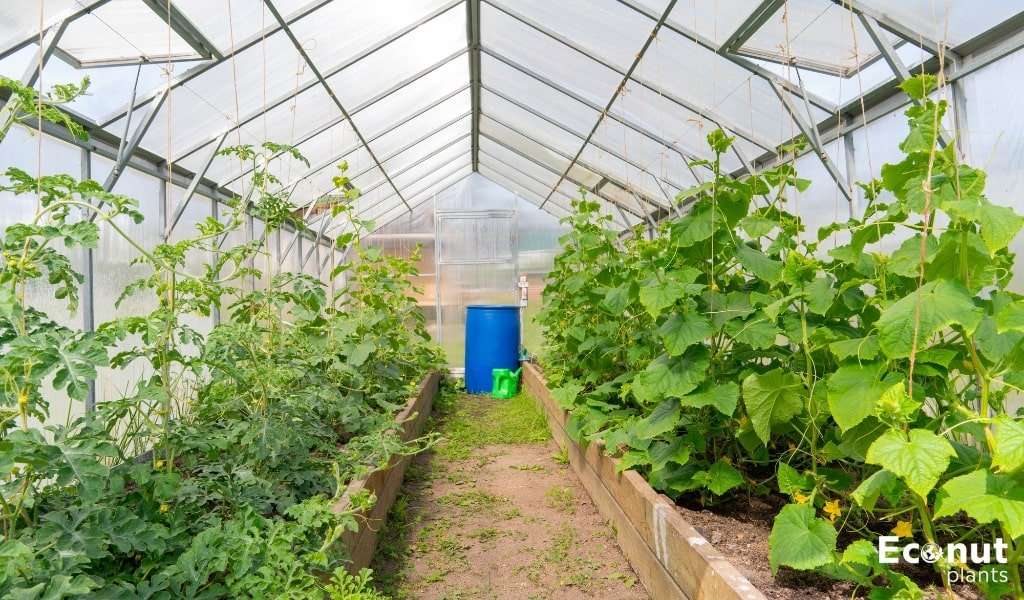Tomatoes and cucumbers grow together this season, even though you’re unsure if it’s a smart idea. Although there are many advantages to companion planting, improper execution can lead to issues.
Two other advantages of having stronger plants in the bed are improved biodiversity, a supply of food, and habitat for a variety of animals. In this article, we include Can You Plant Tomatoes with Cucumbers in Your Garden?
Explaining companion planting
Companion planting, also referred to as interplanting, has a lengthy history in organic gardening. The concept started with a simulation of plant growth in its native environment.
Many plants depend on one another to grow more than they would if they existed in a disconnected habitat. Additionally, plants will be more resistant to disease and pest problems in an environment with more animals, plants, and bugs.
This kind of monoculture is at odds with the way that plants are supposed to grow. It makes sense that large farmers and producers would make this choice because it all boils down to economies of scale. However, as a home gardener, you have the option to intentionally interplant specific flowers, veggies, and herbs to build your harmonious garden ecology.
Reasons to Companion Plant
Selecting companion plants has numerous benefits. Some benefits include luring pollinators, managing illnesses and pests, enhancing flavour, making the most of available light and space, preventing weed growth, and more. When you have a smaller home garden, it can also be a terrific way to save space.
We are mostly concerned with interplanting for similar crop needs when it comes to growing cucumbers and tomatoes. When a plant’s requirements for soil, water, and nutrients are similar, planting it in the same location is usually easier.
A few advantages include attracting pollinators, controlling diseases and pests, improving flavour, optimizing light and space, inhibiting the growth of weeds, and more.
Growing Requirements
When determining if cucumbers and tomatoes can coexist in the garden, it’s important to consider three main factors: soil, water requirements, and sun exposure. These requirements should all be satisfied for the two plants to coexist peacefully.
Soil
Heavy feeders, tomatoes, and cucumbers require rich, well-draining soil that is high in organic matter to thrive and yield maximum amounts. A month or so before planting, add compost to the soil by gently digging it in. This will help your plants thrive.
Plant success is mostly dependent on the growing season’s fertilizer and the compost added before planting. You can decrease this during the growing season by monitoring the plant’s nutritional needs.
When the plants begin to flower, switch to a fertilizer that contains less nitrogen and more potassium and phosphorus. In comparison to the ongoing creation of leaves, this will maximize the growth of fruit and flowers.
Sunlight
Full daylight, or at least six hours of direct sunshine per day, is ideal for planting two warm-season crops: tomatoes and cucumbers. For optimal fruit production, they truly prefer 8–10 hours of sun.
Southern exposure is good since it provides plants with light throughout the day and shields them from the intense afternoon sun, as is the case with most warm-season crops. Note the time of day that the sun rises and sets at the spot, and see if any large trees or buildings ever obscure your view of it.
Your sun-loving warm-season tomatoes and cucumbers will be grateful for this guarantee. Making sure your plants don’t shade one another is an additional important factor to take into account. We’ll talk about the placement and spacing of the two plants in that section.
Watering
Watering is one area where you’ll need to find a harmonious balance. Tomatoes like to dry out in between watering, but cucumbers appreciate moist soil, even though both plants require nearly the same amount of water each week.
The best way to tell if your tomatoes and cucumbers are ready for watering is to stab a finger two to three inches into the ground. The best choices for reliable and efficient watering are drip irrigation systems or soaker hoses. However, if you water in the morning and concentrate on watering the soil rather than the leaves, you can also use a hose.
Planting Placement
Planting these two vegetables together can be a bit of a conundrum to figure out. A lot will depend on the kinds of vegetables you decide to plant. There are determinate and indeterminate tomato types, but there are bushing and vining cucumber kinds.
Your best bet is to pair a bushing cucumber with an indeterminate tomato or a vining cucumber with a determinate tomato; however, you can go with any combination depending on what you require. Let’s discuss every possible combination of plants.
Indeterminate Tomato with a Vining Cucumber
This combination can be the most unstable, so you’ll need to be cautious. Cucumber vines might potentially be trained on the same supports as tomato plants. Diversified planting, which involves mixing different types of plants, can aid in preventing pests.
Here, sun exposure and airflow are the main causes of concern. However, this is something you can do if you are an experienced gardener. In your garden bed, the cucumbers will reduce weeds admirably and function nearly as ground cover. The disadvantage of this is that, in comparison to training the plant to grow vertically, you will yield fewer cucumbers.
Determinate Tomato with a Bushing Cucumber
Finally, planting determinate tomatoes and bushing cucumbers together is an option. They will do better if planted side by side, since if they are placed behind one another, none of them will get tall enough to get sunshine.
Determinate Tomato with a Vining Cucumber
Bushing varieties are the tomatoes that are chosen. They develop to a specific height and produce fruit all at once. Unlike their indeterminate cousins, they won’t grow everywhere, but you still need to use tomato cages and stakes with them for the best support.
By doing this, you can prevent your cucumber’s expanding vines from shading your tomato plant. The cucumber can also continue to receive full sun because your tomato will only reach a certain height.
Indeterminate Tomato with a Bushing Cucumber
This planting arrangement will be the complete opposite of what we just discussed. Plant the indeterminate tomato plant here, allowing it to climb and spread out as much as it pleases, on the back side of your garden bed.
Plant the bushing cucumber on the sunward side of the tomato. This will guarantee enough sunshine for both plants.
Spacing of Plants
Providing your plants with adequate space is crucial, no matter what combination you decide on. In terms of essential nutrients and water, this will help avoid any problems where one plant crowds out another.
Depending on the particular kinds you decide to grow, different plant spacing guidelines will always apply. Even so, if this fundamental guideline is adhered to, all plants and the garden as a whole will benefit from sufficient air circulation.
Potential Drawbacks
There are very few possible problems that interplanting might bring about. Let’s examine some of the most typical problems that gardeners encounter while attempting to properly grow these two veggies together.
Competition for Resources
You will need to take good care of your soil and watering because both crops are heavy feeders, so you don’t want them fighting for the same resources. This may easily be resolved if you adhere to the season’s regular fertilization and watering protocols.
One Plant Shades the Other
If you follow the above criteria, neither plant should have any trouble receiving full light. Just keep in mind that your little tomato seedlings will get very big very quickly and your cucumber seeds that are starting to germinate will soon be sending out vines throughout the garden!
When your plants start to grow and mature, careful preparation before you plant or sow seeds will save you a great deal of trouble.
Increased Pest or Disease Problems
Both species can grow quite dense leaves; therefore, it’s important to have the proper spacing between the two plants to prevent ventilation issues. When interplanting these two plants, your best friends will be stakes, trellises, and cages.
Make sure to properly prune your tomatoes during the entire season. This will contribute to ensuring that the building has enough ventilation.
Our Recommendation
It is best to plant your cucumbers and tomatoes together, as we suggest. A handful of these plants can provide you with an amazing yield this season, even in a small garden. But in general, especially when growing in raised beds, it’s preferable to have a larger garden space for them.
Conclusion
Now that you know tomatoes and cucumbers can live in harmony together in the garden, it’s time to get planting! With little garden maintenance, both of these quickly-growing vegetables will produce an abundance of fruits in your garden.
With a little bit of strategic planning, you will soon be able to enjoy an abundant crop of stunning summer tomatoes.

